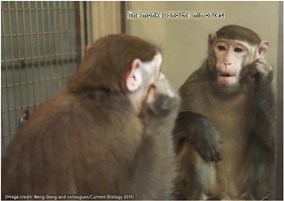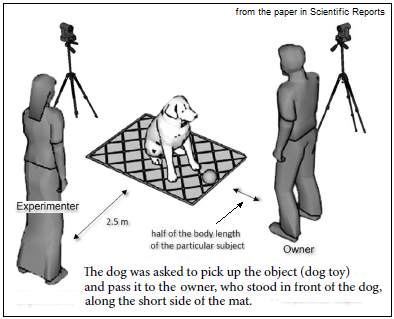Do dogs have a picture of themselves in their minds?, asks S.Ananthanarayanan.
The classic story of a person chopping the branch of the tree that she was sitting on is about knowing the effect one’s actions would have on one’s body. The story has been turned around to see how animals can make out the effect one’s body has upon the environment.
Rita Lenkei, Tamás Faragó, Borbála Zsilák and Péter Pongrácz, from ELTE Eötvös Loránd University, Budapest, Hungary, write in the journal, Nature Scientific Reports, that humans’ best friend (the dog, that is) is as aware of its body as an 18-24-month-old human baby. Humans, the paper says, use a mental representation of their own body when they confront the physical environment. While being aware of one’s body is the beginning of creating a mental picture of oneself, there has been little work on how far non-human animals have this awareness, the paper says.
The studies so far, like the well-known mirror test of the American psychologist, Gordon Gallup Jr, address more developed aspects of self-awareness, rather than just the consciousness of the body, the paper says. Gallup’s mirror test, which was developed in 1970, tests whether an animal has the capacity of visual self-recognition. In the tests, chimpanzees, two male and two female, were placed in separate rooms and gradually familiarized with a full-size mirror that was introduced into the rooms. The reaction of the chimpanzees, on seeing their reflections, progressed from feeling threatened by the image, to exploring the mirror, and behind the mirror, to interacting with the image in the mirror.
The next step was to see if the chimpanzees recognized the images as representation of themselves. For this, the chimpanzees were anaesthetized and marked with an odour-free dye, not apparent to the touch, at places not visible to the animals, like above the eyebrow and the top half of the ear. The significant feature was that the marking could not be seen by the chimpanzee or made out by touch or smell. The chimpanzees were then allowed to recover, in the room, but with the mirror removed. Any acts of touching the marked areas would hence be only by chance, and the frequency of such events, over 30 minutes, was recorded.
The mirrors were then brought back into the rooms. Now, when the chimpanzees saw their reflections, they would see an image that was marked with the dye. The frequency of the chimpanzees touching the marked areas on their own bodies was then recorded. It was found that these events were now four to ten times more often. The chimpanzees would sometimes look at, or smell their fingers after touching the marks, and turn and adjust their position before the mirrors to better view the marks. In a control test, if the chimpanzees were marked without having been first exposed to the mirror, there was no change in the mark-touching behavior before and after the mirror was introduced.
As the chimpanzees that had been trained with the mirror could apparently make out the mark in the image as a mark on themselves, it was considered that the chimpanzees had recognized the images as representation of themselves. Other animals that ‘passed’ the mirror test are European magpies, certain dolphin and whale species, certain species of primates, an instance of an elephant and, significantly, human babies when they are about 18 months old.

Human babies appear to make an early start, at about 5 months of age. The paper cites a study which found that babies, at 5 months, could tell apart movement of their own limbs, as opposed to video recordings of movements by themselves or others. The feedback of what the infant sees, as a cause and the result of the infant’s action, has been found to relate to the emergence of self-awareness, the paper says. In order to glimpse the mechanism of a stage before the awareness that Gallup was able to show, the authors investigated the body awareness of the dog, canis familiaris. The dog, the authors say, has not displayed any of the features of higher order self-awareness, but its behavior and character suggest that it has body-awareness.
In any organism, the paper says, body-awareness would be an ability that would enable the organism to navigate the environment when the shape and size of its body becomes an obstacle. This awareness, the paper quotes a study to say, is “the ability to hold information about one’s own body in mind, as an explicit object, in relation to other objects in the world,” and considers the ability to be a ‘building block of self-representation.’
The experiments with dogs were an adaptation of experiments based on observations of the Swiss psychologist Jean Piaget, where human toddlers were required to hand over the blanket that they were standing upon. Children over 18-24 months old were able to identity the obstacle and step off the blanket. The dogs were similarly challenged, to identify their own body as the obstacle in a given task and then act to remove the obstacle.
The task set for the dogs was that they were to pick up an object, which was a ball of string, which was placed on a mat that the dog was standing on, and offer it to the handler, on command. The first requirement was hence that dogs be trained to perform this task, apart from general obedience training, like sitting on command.
The experiment, proper, was the same task, but where the object was not simply placed on the mat, but was either attached to the mat, the ‘test’ condition, or attached to the ground, by a short halter, the ‘control’ condition. In both cases, the object could not be lifted – attached to the ground in the ‘control’ condition and because of the weight of the dog, in the ‘test’ condition. The difference was that in the first case, the dog would feel a pull under its forepaws.

In the first case, the dog would need to see that the problem was its weight on the mat, and step off, when the object would come up. In the second case, lifting the object was not possible, although the dog would also step off the mat, in time. The objective was to see how soon the dog stepped off the mat in the cases that the object was fixed to the mat.
The result of the trials, with 32 dogs, which remained after several results were discarded for technical reasons, was that the dogs came off the mat more frequently and sooner, in the ‘test’ condition, compared the ‘control ’- an indicator that the dogs were able to work it out, based on the pull under their paws in the cases where the object was attached to the mat, that it was their own weight that was preventing the object from being moved, and to act, by stepping off the mat. “. This is the first convincing evidence of body awareness through the understanding of the consequence of own actions in a species where previously no higher-order self-representation capacity was found,” the paper says.
Human babies succeed in the ‘body as obstacle’ test about the same time as the ‘mirror mark test, the paper says. Dogs cannot manage the ‘mirror mark.’ This may be because visual cues are not important instruments for the dog, which relies more on mechanical or scent related cues, the paper says. Self-representation would hence involve different cognitive skills, and the building blocks would vary according to the species, the paper concludes.
------------------------------------------------------------------------------------------ Do respond to : response@simplescience.in-------------------------------------------